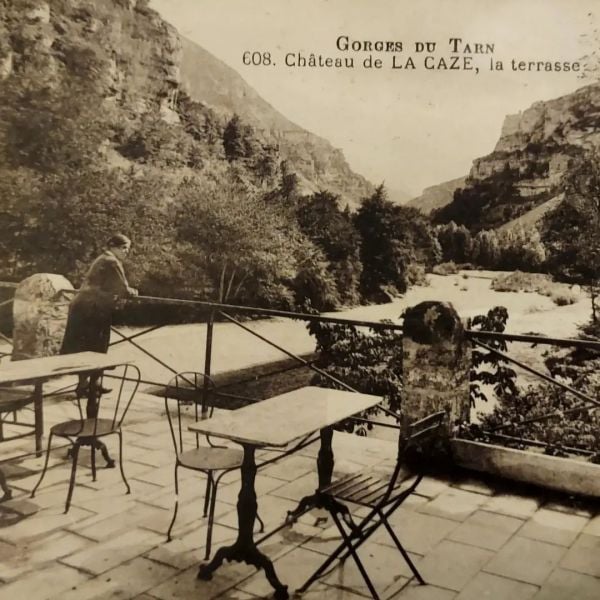The history of our chateau hotel in Lozère
History of the Château de la Caze
The construction of the Château de la Caze is closely linked to the history of the Sainte-Enimie monastery. Since 1271, the jurisdiction of the priors of Sainte-Enimie has extended over the area known as La Caze.
The Alamand family, descended from the nobility of Mende, is one of the region's leading families. It has provided several dignitaries to the Church and several priors to the Sainte-Enimie monastery.
On May 17, 1488, Soubeyrane married Guillaume de Montclar, who then took the name Alamand. With the help of his uncle, they acquired the La Caze estate. The couple commissioned the Château in 1489, and its construction was completed on December 2, 1490.
From this union were born five daughters: Gabrielle, Jeanne, Loyse, Antoinette, and Françoise. According to legend, these young women, beautiful and intrepid, were nicknamed by the poet Louis Jourdan the "Nymphs of the Tarn." They attracted the elegant nobility of Gévaudan and Rouergue.
In 1524, Gabrielle, the eldest, succeeded her mother Soubeyrane. She married her cousin Bernard de Montclar. Her sisters followed different paths: Jeanne married Berail de Pelamorgue, Loyse married Jean Boussuge, Antoinette entered a convent, and Françoise married Bernard de Curières.
All of Soubeyrane's daughters became widows except one. Anne was born to Françoise Alamand and Bernard de Curières. Gabrielle bequeathed her inheritance to her niece Anne de Curières in her will of March 26, 1563.
At that time, the Wars of Religion were ravaging Gévaudan. Churches were looted and convents ransacked. Anne married Bertrand de Mostuéjouls, a valiant warrior, on December 12, 1563.
Anne died childless, and Bertrand remarried Marguerite de Chapelu, daughter of the lord of Charbonnières. They had a daughter, Jacquette de Mostuéjouls, who took over the estate upon her father's death. Jacquette married Jean de Maillan, lord of Grandlac, thus uniting the estates of Grandlac and La Caze.
Jacquette and Jean had a son, David, who succeeded them, and then a grandson, François. After Jacquette's death, Jean de Maillan remarried Anne des Ondes in 1598. It was Anne des Ondes who commissioned the paintings in the Salle des Nymphes in 1627, created by the painter Prunier.
In the second half of the 17th century, François, lord of La Caze, had two children with Françoise de Loubeyrat: Jean-Baptiste and Marthe.
Jean-Baptiste became Lord of La Caze upon his father's death. In 1712, he married Jeanne Brun de Montesquieu. They had several children, including Melchior and Aldebert de Mailhan. However, the Maillan family was experiencing financial difficulties; Madame de Thomassy, Jean-Baptiste's sister, bought the Grandlac estate to preserve the family property.
During the French Revolution, the Maillan family was forced to emigrate. During this period, the château was requisitioned, probably used as a prison, and then sold as national property.
The Château de la Caze has always been designed for well-being and comfort, bearing witness to a rich and feminine history, from the 15th century to today.
The 10 rooms of the Château and their names
At Château de la Caze, each room is a vibrant tribute to an iconic figure in the family that shaped this historic site. Much more than just accommodation, each space immerses you in an atmosphere where past and present blend harmoniously, for a stay as authentic as it is refined.
- Anne — Anne des Ondes, second wife of Jean de Maillan, who had the Salle des Nymphes decorated in 1627.
- Guillaume — Guillaume de Montclar, husband of Soubeyrane, first sponsor of the castle.
- Loyse — Loyse Alamand, one of the five daughters of Soubeyrane and Guillaume, known as one of the Nymphs of the Tarn.
- Jeanne — Jeanne Alamand, sister of Loyse, wife of Berail de Pelamorgue.
- Soubeyrane — Founding matriarch, wife of Guillaume de Montclar, behind the construction of the castle.
- Bertrand — Bertrand de Mostuéjouls, warrior and husband of Anne, father of Jacquette.
- Aldebert — Aldebert de Mailhan, son of Jean-Baptiste, last representative of the family to reside at the castle before the Revolution.
- Melchior — Melchior de Mailhan, son of Jean-Baptiste, becomes Baron de La Caze after his father.
- Jacquette — Jacquette de Mostuéjouls, heiress of La Caze and wife of Jean de Maillan.
- Gabrielle — Gabrielle Alamand, eldest of Soubeyrane’s daughters, who perpetuated the line through her niece Anne.


